A Scenario-Based Simulation of Land System Changes on Dietary Changes: A Case Study in China
Abstract
1. Introduction
2. Materials and Methods
2.1. Data Sources
2.2. Overall Approach
2.3. Land Systems Classification
2.4. CLUMondo Model
2.5. Land Use Demand under Dietary Change Scenarios
3. Results
3.1. Land System Changes under Different Dietary Scenarios
3.2. Spatial Changes to Land Use and Land Use Intensity
3.3. Changes in Lifecycle Environmental Impacts from Food Production
4. Discussion
4.1. Comparison with Previous Studies
4.2. Validation of the Method and Uncertainty
4.3. Effects of Dietary Change
5. Conclusions
- The demand for food dominated by dietary change determines the land use intensity of the land system. If dietary change maintains the current trend, land use intensity of the cropland system would also increase, and many forest systems and grassland systems would be reclaimed as cropland systems. Moreover, the development intensity and scope of animal husbandry would increase significantly. In contrast, both land use intensity and livestock density decrease under a balanced scenario.
- The results also show that land system change has a strong spatial heterogeneity. Under the trend scenario, the intensification and expansion of agriculture and animal husbandry are mainly distributed in Northwest China, North China, and Northeast China, where the intensity of cropland was low in the past and the ecosystem was relatively fragile. Moreover, the carbon footprint, water footprint, and ecological footprint from food production would have sharp increases. In contrast, land systems in these places are more stable under the balanced scenario. Additionally, the intensity of the cropland system in Southwest China and Central China would reduce, and livestock density would also decrease in East China and South China.
- The dramatic divergence of the two dietary change scenarios reveals that adopting a balanced diet could offer considerable environmental benefits. Owing to the lower demand for food, popularizing more balanced diets contributes to cutting down land use intensity, thereby moving natural systems away from the intensification and expansion of agriculture and animal husbandry, lowering lifecycle environmental impacts, and implementing a policy of returning croplands to grasslands and forests in China. Therefore, popularizing balanced diets could be a win–win for human health and environmental sustainability.
Supplementary Materials
Author Contributions
Funding
Conflicts of Interest
References
- Tilman, D.; Clark, M. Global diets link environmental sustainability and human health. Nature 2017, 515, 508–522. [Google Scholar] [CrossRef] [PubMed]
- Song, G.B.; Li, M.J.; Fullana-I-Palmer, P.; Williamson, D.; Wang, Y.X. Dietary changes to mitigate climate change and benefit public health in China. Sci. Total Environ. 2017, 577, 289–298. [Google Scholar] [CrossRef] [PubMed]
- Dietary Guidelines for Chinese Residents. Available online: http://dg.cnsoc.org/index.html (accessed on 8 August 2019).
- Alexander, P.; Rounsevell, M.; Dislich, C.; Dodson, J.R.; Engstrom, K.; Moran, D. Drivers for Global Agricultural Land Use Change: The Nexus of Diet, Population, Yield and Bioenergy. Glob. Environ. Chang. 2015, 35, 138–147. [Google Scholar] [CrossRef]
- Pan, A. Red meat consumption and mortality: Results from 2 prospective cohort studies. Arch. Intern. Med. 2012, 172, 555–563. [Google Scholar] [CrossRef] [PubMed]
- Zhou, M.G.; Wang, H.D.; Zhu, J.; Chen, W.; Wang, L.; Liu, S.; Li, Y.; Wang, L.; Liu, Y.; Yin, P.; et al. Cause-specific mortality for 240 causes in China during 1990–2013: A systematic subnational analysis for the Global Burden of Disease Study 2013. Lancet 2016, 387, 251–272. [Google Scholar] [CrossRef]
- Aune, D.; Ursin, G.; Veierød, M.B. Meat consumption and the risk of type 2 diabetes: A systematic review and meta-analysis of cohort studies. Diabetologia 2009, 52, 2277–2287. [Google Scholar] [CrossRef]
- Hu, F.B. Globalization of diabetes: The role of diet, lifestyle, and genes. Diabetes Care 2011, 34, 1249–1257. [Google Scholar] [CrossRef] [PubMed]
- Popkin, B.M. The nutrition transition in low-income countries: An emerging crisis. Nutr. Rev. 1994, 52, 285–298. [Google Scholar] [CrossRef]
- Huang, T.; Yang, B.; Zheng, J.; Li, G.; Wahlqvist, W.L.; Li, D. Coronary disease mortality and cancer incidence in vegetarians: A meta-analysis and systematic review. Ann. Nutr. Metab. 2012, 60, 233–240. [Google Scholar] [CrossRef]
- Song, G.B.; Gao, X.B.; Pere, F.; Lv, D.; Zhu, Z.; Wang, Y.; Bayer, L.B. Shift from feeding to sustainably nourishing urban China: A crossing-disciplinary methodology for global environment-food-health nexus. Sci. Total Environ. 2019, 647, 716–724. [Google Scholar] [CrossRef]
- Leanne, N.P.; Jed, O.K. Land use for animal production in global change studies: Defining and characterizing a framework. Glob. Chang. Biol. 2017, 23, 4457–4471. [Google Scholar] [CrossRef]
- Carlssonkanyama, A.; Gonzalez, A.D. Potential Contributions of Food Consumption Patterns to Climate Change. Am. J. Clin. Nutr. 2009, 89, 1704–1709. [Google Scholar] [CrossRef] [PubMed]
- Thomas, N.; Niels, J.; Llorenç, M.C.; Rita, S. Environmental impacts of food consumption and nutrition: Where are we and what is next? Int. J. Life Cycle Assess. 2016, 21, 607–620. [Google Scholar] [CrossRef]
- Verburg, P.H.; Erb, K.; Mertz, O.; De Espindola, G.M. Land System Science: Between Global Challenges and Local Realities. Curr. Opin. Environ. Sustain. 2013, 5, 433–437. [Google Scholar] [CrossRef] [PubMed]
- Reenberg, A. Land System Science: Handling Complex Series of Natural and Socio-Economic Processes. J. Land Use Sci. 2009, 4, 1–4. [Google Scholar] [CrossRef]
- Rounsevell, M.; Pedroli, B.; Erb, K.; Gramberger, M.; Busck, A.G.; Haberl, H.; Kristensen, S.M.; Kuemmerle, T.; Lavorel, S.; Lindner, M. Challenges for Land System Science. Land Use Policy 2012, 29, 899–910. [Google Scholar] [CrossRef]
- Turner, B.; Janetos, A.C.; Verburg, P.H.; Murray, A.T. Land System Architecture: Using Land Systems to Adapt and Mitigate Global Environmental Change. Glob. Environ. Chang. 2013, 23, 395–397. [Google Scholar] [CrossRef]
- Guneralp, B.; Seto, K.C. Evidence of Urban Land Teleconnections and Impacts on Hinterlands. Curr. Opin. Environ. Sustain. 2013, 5, 445–451. [Google Scholar] [CrossRef]
- Wu, W.; Verburg, P.H.; Tang, H. Climate Change and the Food Production System: Impacts and Adaptation in China. Reg. Environ. Chang. 2014, 14, 1–5. [Google Scholar] [CrossRef]
- Verburg, P.H.; Mertz, O.; Erb, K.; Haberl, H.; Wu, W. Land System Change and Food Security: Towards Multi-Scale Land System Solutions. Curr. Opin. Environ. Sustain. 2013, 5, 494–502. [Google Scholar] [CrossRef]
- Messina, J.P.; Pan, W. Different Ontologies: Land Change Science and Health Research. Curr. Opin. Environ. Sustain. 2013, 5, 515–521. [Google Scholar] [CrossRef] [PubMed]
- Van Asselen, S.; Verburg, P.H. A Land System Representation for Global Assessments and Land-Use Modeling. Glob. Chang. Biol. 2012, 18, 3125–3148. [Google Scholar] [CrossRef] [PubMed]
- Christine, O.; Andreas, H.; Peter, H.V. Operationalizing a land systems classification for Laos. Landsc. Urban Plan. 2018, 169, 229–240. [Google Scholar] [CrossRef]
- Jiang, H.; Xu, X.; Guan, M.; Wang, L.; Huang, Y.; Liu, Y. Simulation of Spatiotemporal Land Use Changes for Integrated Model of Socioeconomic and Ecological Processes in China. Sustainability 2019, 11, 3627. [Google Scholar] [CrossRef]
- Azimi Sardari, M.R.; Bazrafshan, O.; Panagopoulos, T.; Sardooi, E.R. Modeling the Impact of Climate Change and Land Use Change Scenarios on Soil Erosion at the Minab Dam Watershed. Sustainability 2019, 11, 3353. [Google Scholar] [CrossRef]
- Liu, Z.; Verburg, P.H.; Wu, J.; He, C. Understanding Land System Change through Scenario-Based Simulations: A Case Study from the Drylands in Northern China. Environ. Manag. 2017, 59, 440–454. [Google Scholar] [CrossRef] [PubMed]
- Ornetsmuller, C.; Verburg, P.H.; Heinimann, A. Scenarios of Land System Change in the Lao Pdr: Transitions in Response to Alternative Demands on Goods and Services Provided by the Land. Appl. Geogr. 2016, 75, 1–11. [Google Scholar] [CrossRef]
- Sarah, W.; Elizabeth, A.S.; Catharina, J.E.S.; Peter, H.V. Meeting global land restoration and protection targets: What would the world look like in 2050? Glob. Environ. Chang. 2018, 52, 259–272. [Google Scholar] [CrossRef]
- Dong, F.; Fuller, F.H. Dietary Structural Change in China’s Cities: Empirical Fact or Urban Legend? Can. J. Agric. Econ. 2010, 58, 73–91. [Google Scholar] [CrossRef]
- Durazzo, A. The Close Linkage between Nutrition and Environment through Biodiversity and Sustainability: Local Foods, Traditional Recipes, and Sustainable Diets. Sustainability 2019, 11, 2876. [Google Scholar] [CrossRef]
- Hasegawa, T.; Fujimori, S.; Ito, A.; Takahashi, K.; Masui, T. Global Land-Use Allocation Model Linked to an Integrated Assessment Model. Sci. Total Environ. 2017, 580, 787–796. [Google Scholar] [CrossRef] [PubMed]
- Verburg, P.H.; Dearing, J.A.; Dyke, J.G.; Der Leeuw, S.V.; Seitzinger, S.P.; Steffen, W.; Syvitski, J.P.M. Methods and Approaches to Modelling the Anthropocene. Glob. Environ. Chang. 2016, 39, 328–340. [Google Scholar] [CrossRef]
- Van Asselen, S.; Verburg, P.H. Land Cover Change or Land-Use Intensification: Simulating Land System Change with a Global-Scale Land Change Model. Glob. Chang. Biol. 2013, 19, 3648–3667. [Google Scholar] [CrossRef] [PubMed]
- Overmars, K.P.; Helming, J.F.M.; Van Zeijts, H.; Jansson, T.; Terluin, I.J. A Modelling Approach for the Assessment of the Effects of Common Agricultural Policy Measures on Farmland Biodiversity in the Eu27. J. Environ. Manag. 2013, 126, 132–141. [Google Scholar] [CrossRef] [PubMed]
- Veldkamp, A.; Fresco, L.O. Clue: A Conceptual Model to Study the Conversion of Land Use and Its Effects. Ecol. Model. 1996, 85, 253–270. [Google Scholar] [CrossRef]
- Verburg, P.H.; Soepboer, W.; Veldkamp, A.; Limpiada, R.; Espaldon, V.; Mastura, S.S.A. Modeling the Spatial Dynamics of Regional Land Use: The Clue-S Model. Environ. Manag. 2002, 30, 391–405. [Google Scholar] [CrossRef] [PubMed]
- Verburg, P.H.; Overmars, K.P. Combining Top-Down and Bottom-up Dynamics in Land Use Modeling: Exploring the Future of Abandoned Farmlands in Europe with the Dyna-Clue Model. Landsc. Ecol. 2009, 24, 1167–1181. [Google Scholar] [CrossRef]
- National Bureau of Statistics of the People’s Repubic of China. Available online: http://data.stats.gov.cn/ (accessed on 8 August 2019).
- FAO Geographic Information Network. Available online: http://www. fao.org/geonetwork/ (accessed on 8 August 2019).
- Resources and Environmental Data Cloud Platform. Available online: http://www.resdc.cn/ (accessed on 10 September 2019).
- Faostat. Available online: http://www.fao.org/faostat/en/#data (accessed on 8 August 2019).
- World Population Prospects: The 2015 Revision. Available online: https://population.un.org/wpp/Publications/ (accessed on 8 August 2019).
- Chinese Government Network. Government Affairs. Available online: http://www.gov.cn/zhengce/content/2017-02/04/content_5165309.htm (accessed on 8 August 2019).
- Double Pyramid Database. Available online: https://www.barillacfn.com/en/publications/double-pyramid-2012 (accessed on 20 July 2019).
- National Administration of Surveying, Mapping, and Geoinformation of China. Available online: http://en.nasg.gov.cn/ (accessed on 8 August 2019).
- Fang, C.; Liu, H.; Luo, K.; Yu, X. Comprehensive Regionalization of Human Geography in China. Acta Geogr. Sin. 2017, 72, 179–196. [Google Scholar] [CrossRef]
- David, A.E.; Jasper, V.V.; Peter, H.V. Accounting for monogastric livestock as a driver in global land use and cover change assessments. J. Land Use Sci. 2017, 12, 1–16. [Google Scholar] [CrossRef]
- Liu, J.; Kuang, W.; Zhang, Z.; Xu, X.; Qin, Y.; Ning, J.; Zhou, W.; Zhang, S.; Li, R.; Yan, C. Spatiotemporal Characteristics, Patterns, and Causes of Land-Use Changes in China since the Late 1980s. J. Geogr. Sci. 2014, 24, 195–210. [Google Scholar] [CrossRef]
- Cuba, N. Research Note: Sankey Diagrams for Visualizing Land Cover Dynamics. Landsc. Urban Plan. 2015, 139, 163–167. [Google Scholar] [CrossRef]
- Barilla Center for Food & Nutrition. Double Pyramid 2012 Enabling Sustainable Food Choices; Barilla Center for Food & Nutrition: Parma, Italy, 2012. [Google Scholar]
- Behrens, P.; Kiefte-de Jong, J.C.; Bosker, T.; Rodrigues, J.F.; de Koning, A.; Tukker, A. Evaluating the environmental impacts of dietary recommendations. Proc. Natl. Acad. Sci. USA 2017, 114, 13412–13417. [Google Scholar] [CrossRef] [PubMed]
- Alexander, P.; Brown, C.; Arneth, A.; Finnigan, J.; Rounsevell, M. Human Appropriation of Land for Food: The Role of Diet. Glob. Environ. Chang. 2016, 41, 88–98. [Google Scholar] [CrossRef]
- Davy, V.; Sara, C.; Bernd, M.G.; Giovanni, B. The water footprint of different diets within European sub-national geographical entities. Nat. Sustain. 2018, 1, 518–525. [Google Scholar] [CrossRef]
- Song, G.B.; Li, M.J.; Semakula, H.M.; Zhang, S.S. Food consumption and waste and the embedded carbon, water and ecological footprints of households in China. Sci. Total Environ. 2015, 529, 191–197. [Google Scholar] [CrossRef] [PubMed]
- Pontius, R.G.; Schneider, L. Land-Cover Change Model Validation by an Roc Method for the Ipswich Watershed, Massachusetts, USA. Agric. Ecosyst. Environ. 2001, 85, 239–248. [Google Scholar] [CrossRef]
- Kastner, T.; Rivas, M.J.I.; Koch, W.; Nonhebel, S. Global Changes in Diets and the Consequences for Land Requirements for Food. Proc. Natl. Acad. Sci. USA 2012, 109, 6868–6872. [Google Scholar] [CrossRef] [PubMed]
- Katalin, P.; Rob, A.; Michel, B.; Catharina, J.E.S.; Marjin, V.; Rik, L. Mapping and modelling trade-offs and synergies between grazing intensity and ecosystem services in rangelands using global-scale datasets and models. Glob. Environ. Chang. 2014, 29, 223–234. [Google Scholar] [CrossRef]
- Popp, A.; Lotzecampen, H.; Bodirsky, B.L. Food Consumption, Diet Shifts and Associated Non-Co2 Greenhouse Gases from Agricultural Production. Glob. Environ. Chang. 2010, 20, 451–462. [Google Scholar] [CrossRef]
- Stehfest, E.; Bouwman, L.; Van, V.D.P.; Den, E.M.G.J.; Eickhout, B.K.P. Climate Benefits of Changing Diet. Clim. Chang. 2009, 95, 83–102. [Google Scholar] [CrossRef]
- De, B.E.; Dagevos, H. Reducing Meat Consumption in Today’s Consumer Society: Questioning the Citizen-Consumer Gap. J. Agric. Environ. Ethics 2012, 25, 877–894. [Google Scholar] [CrossRef]
- FAO. Livestock’s Long Shadow: Environmental Issues and Options; FAO: Rome, Italy, 2006. [Google Scholar]
- FAO. World livestock 2013: Changing Disease Landscapes; FAO: Rome, Italy, 2013. [Google Scholar]
- Ilea, R. Intensive Livestock Farming: Global Trends, Increased Environmental Concerns, and Ethical Solutions. J. Agric. Environ. Ethics 2009, 22, 153–167. [Google Scholar] [CrossRef]
- Alexander, P.; Rabin, S.; Anthoni, P.; Henry, R.; Pugh, T.A.M.; Rounsevell, M.; Arneth, A. Adaptation of Global Land Use and Management Intensity to Changes in Climate and Atmospheric Carbon Dioxide. Glob. Chang. Biol. 2018, 24, 2791–2809. [Google Scholar] [CrossRef] [PubMed]
- Tilman, D.; Balzer, C.; Hill, J.; Befort, B.L. Global food demand and the sustainable intensification of agriculture. Proc. Natl. Acad. Sci. USA 2011, 108, 20260–20264. [Google Scholar] [CrossRef] [PubMed]
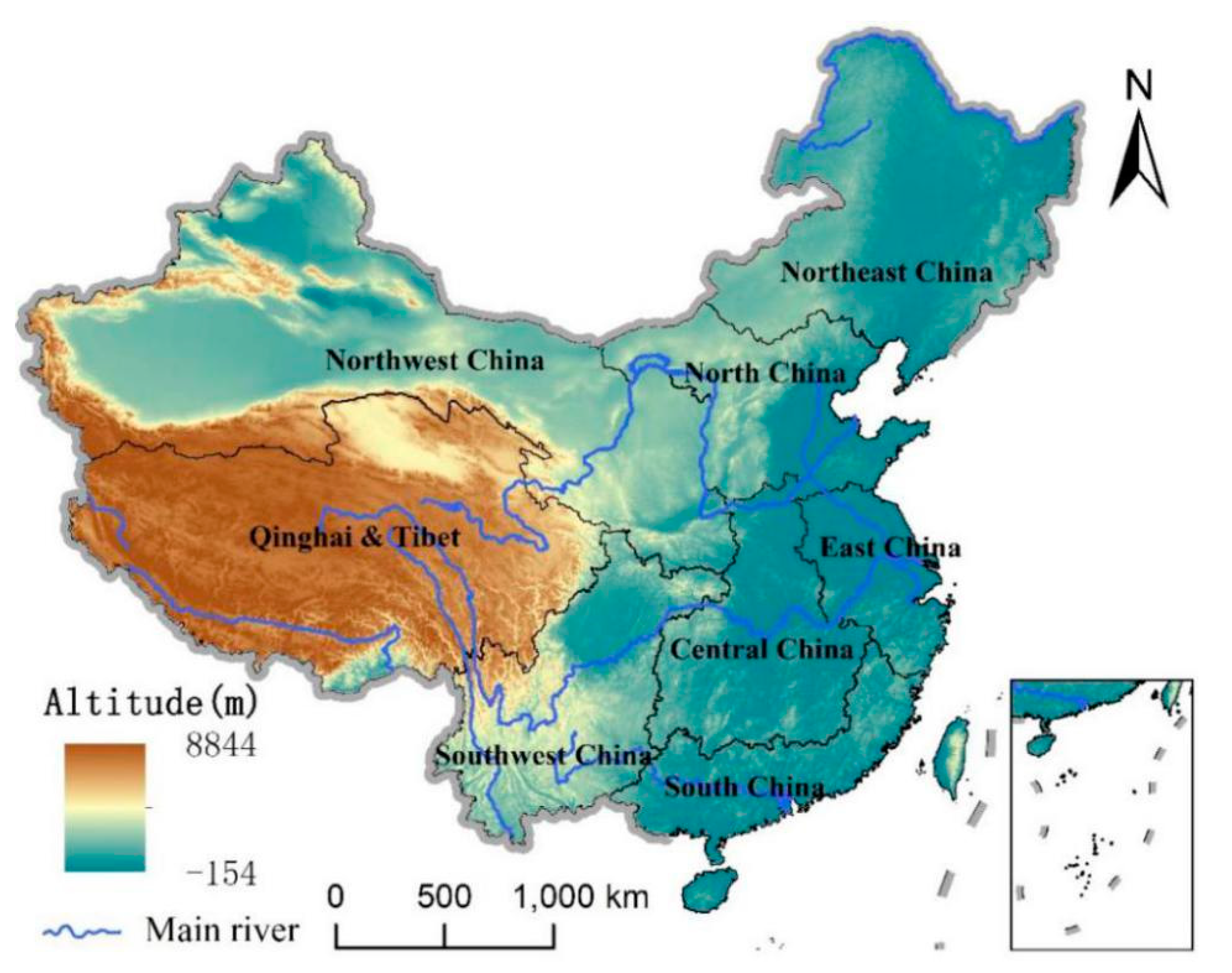
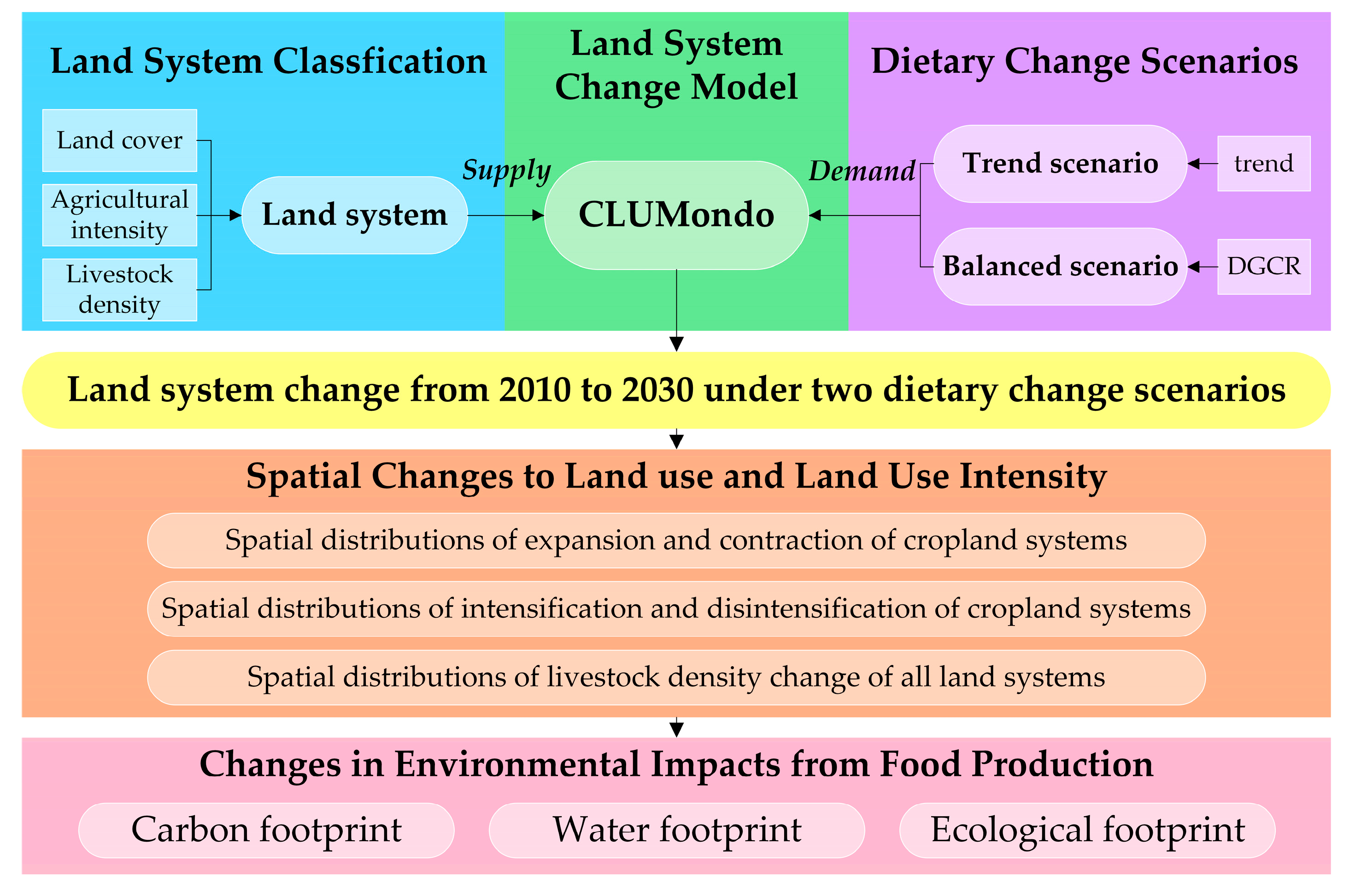
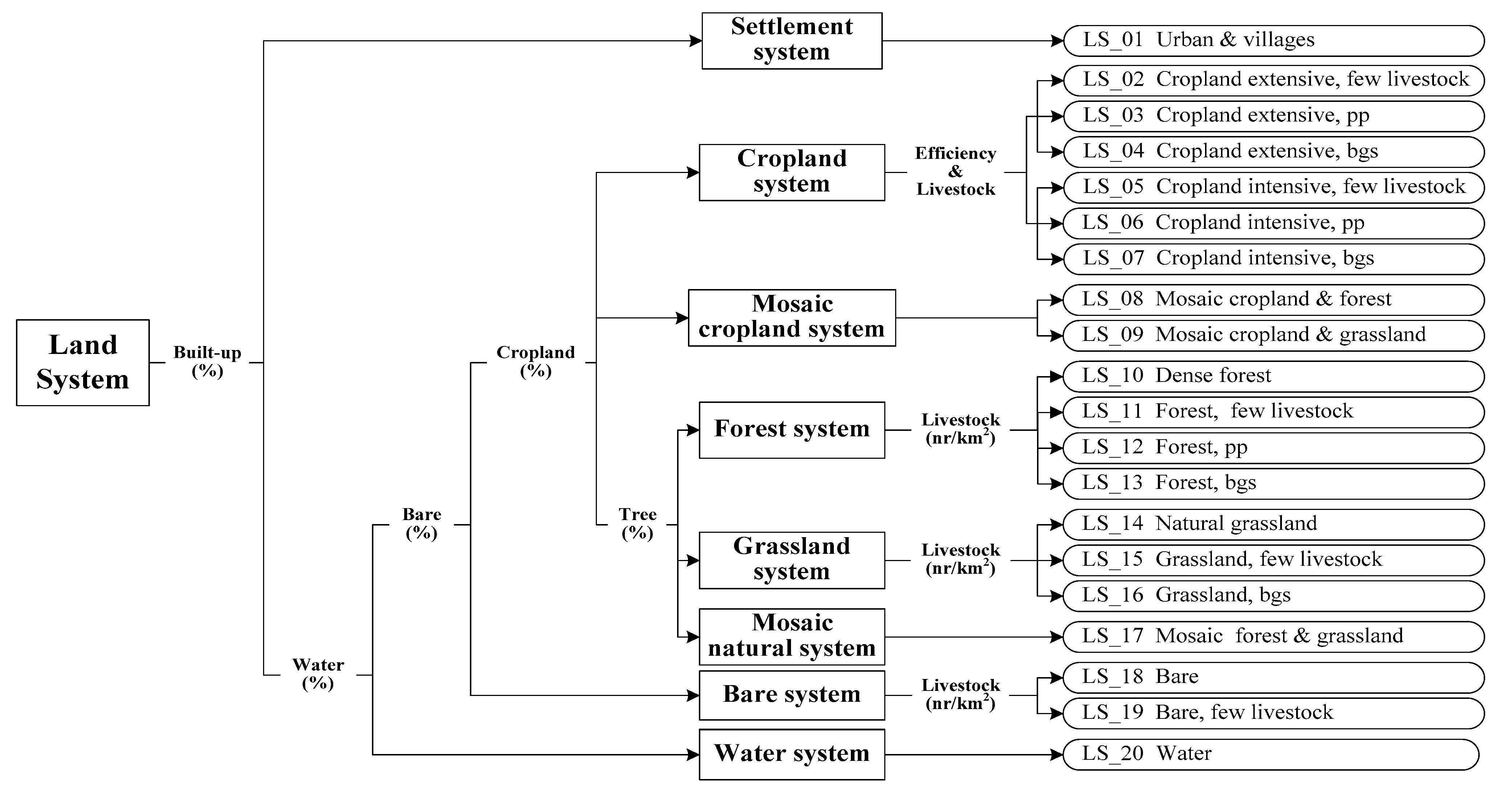
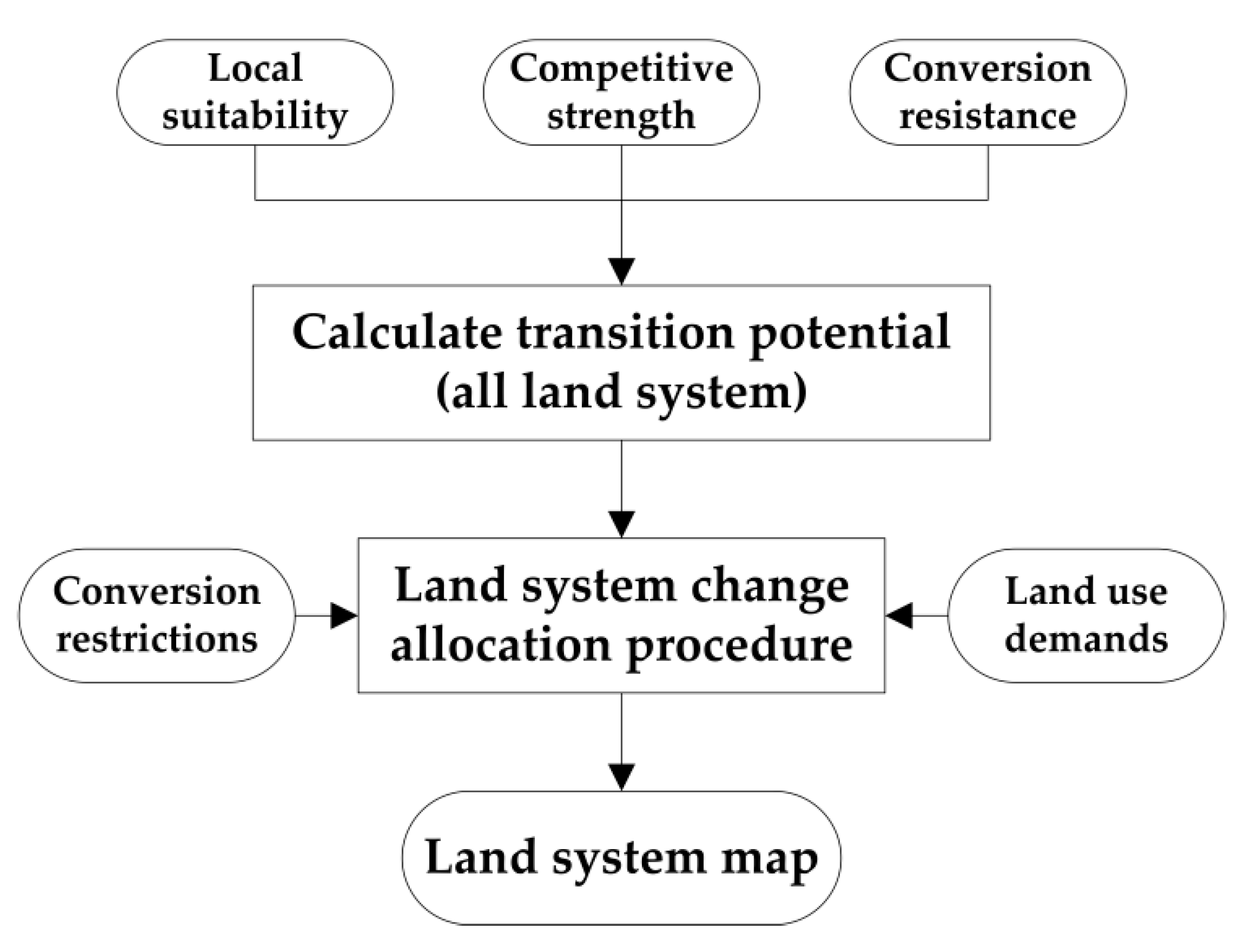
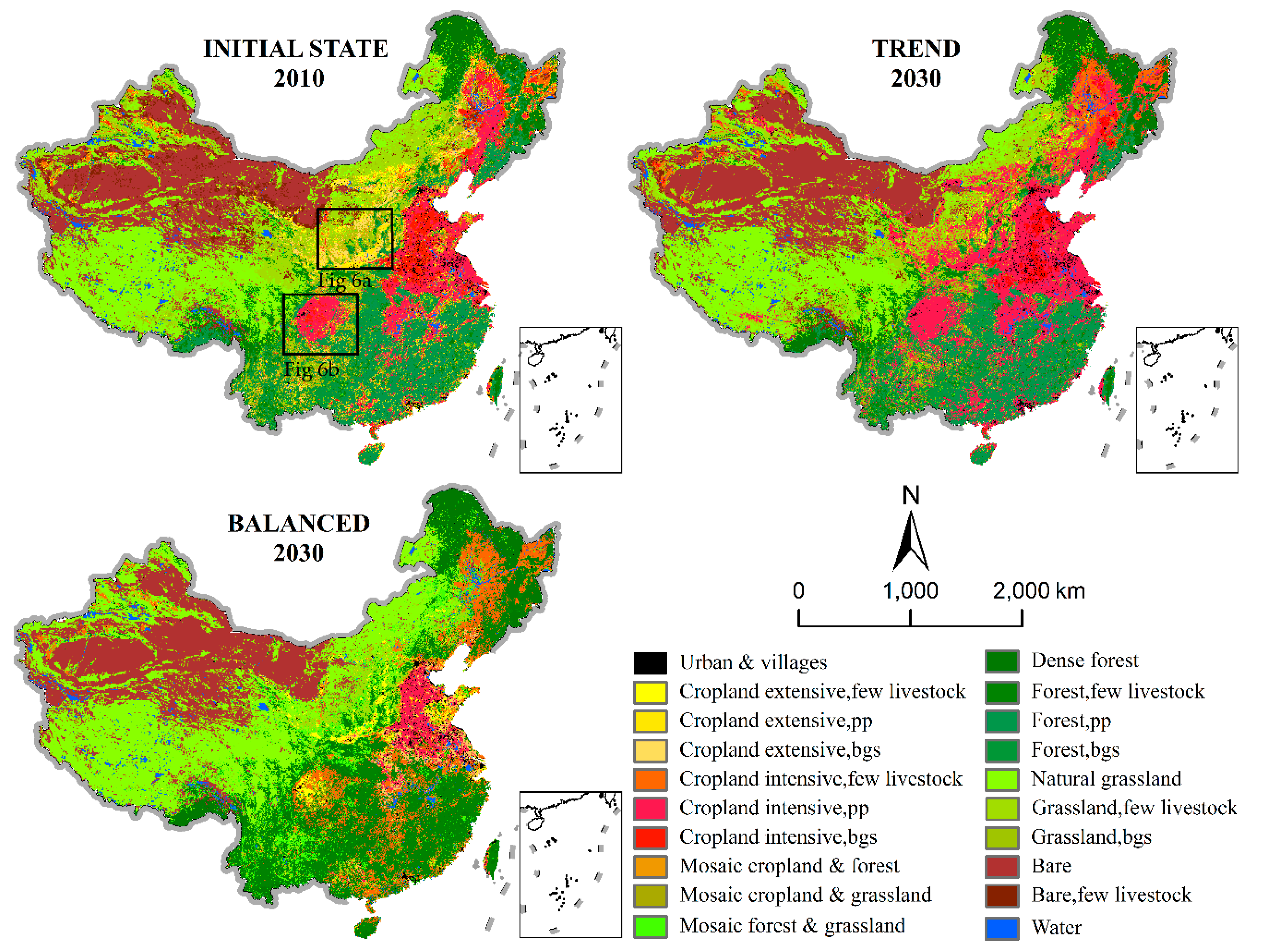
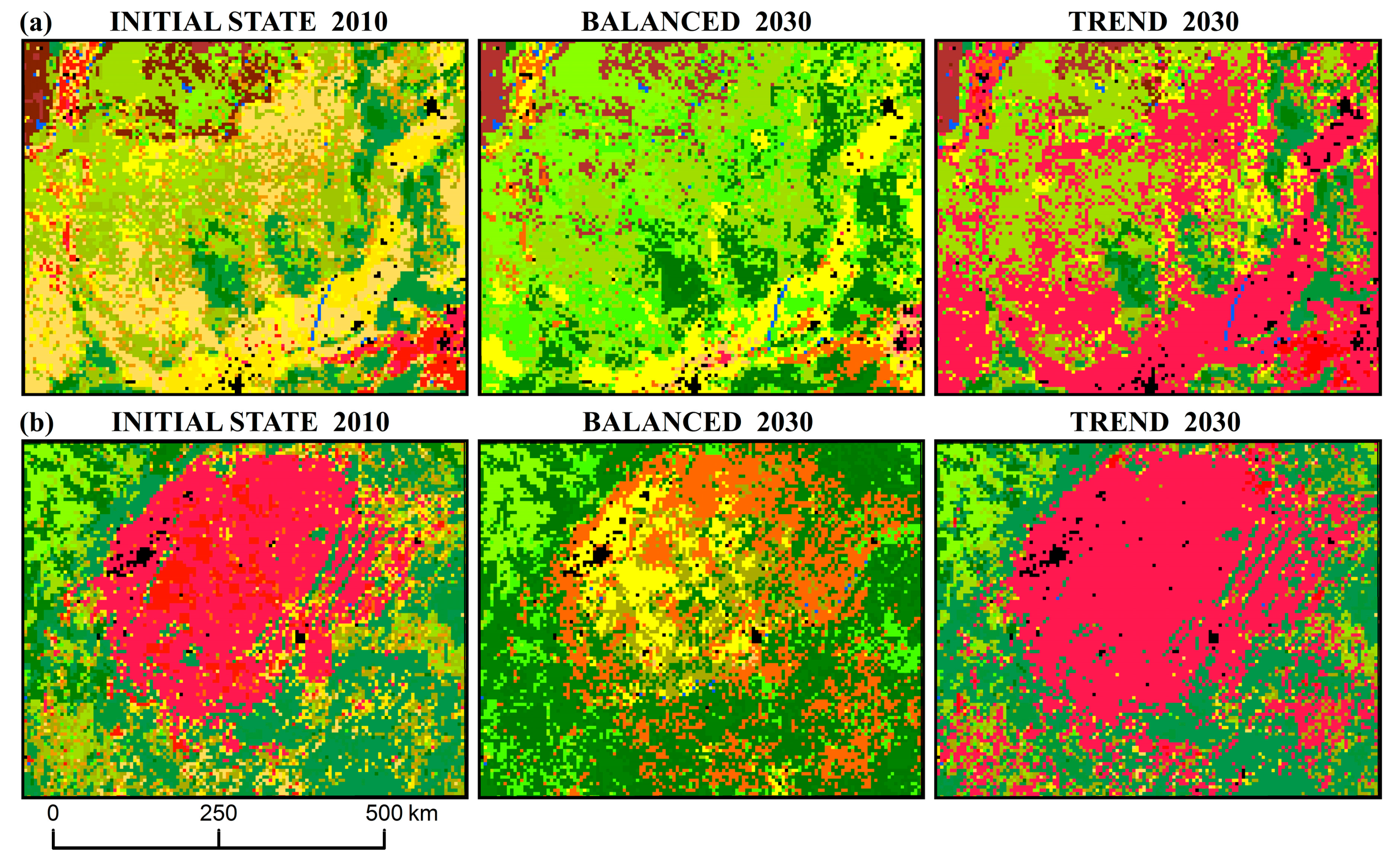
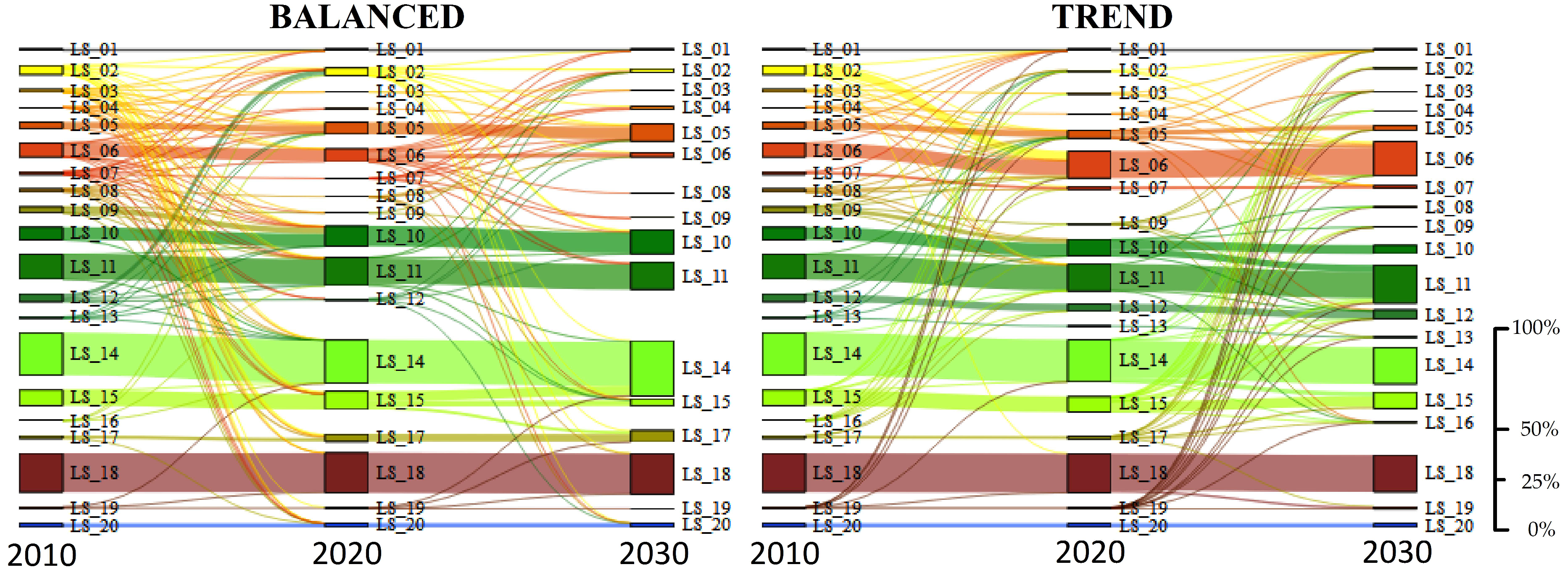
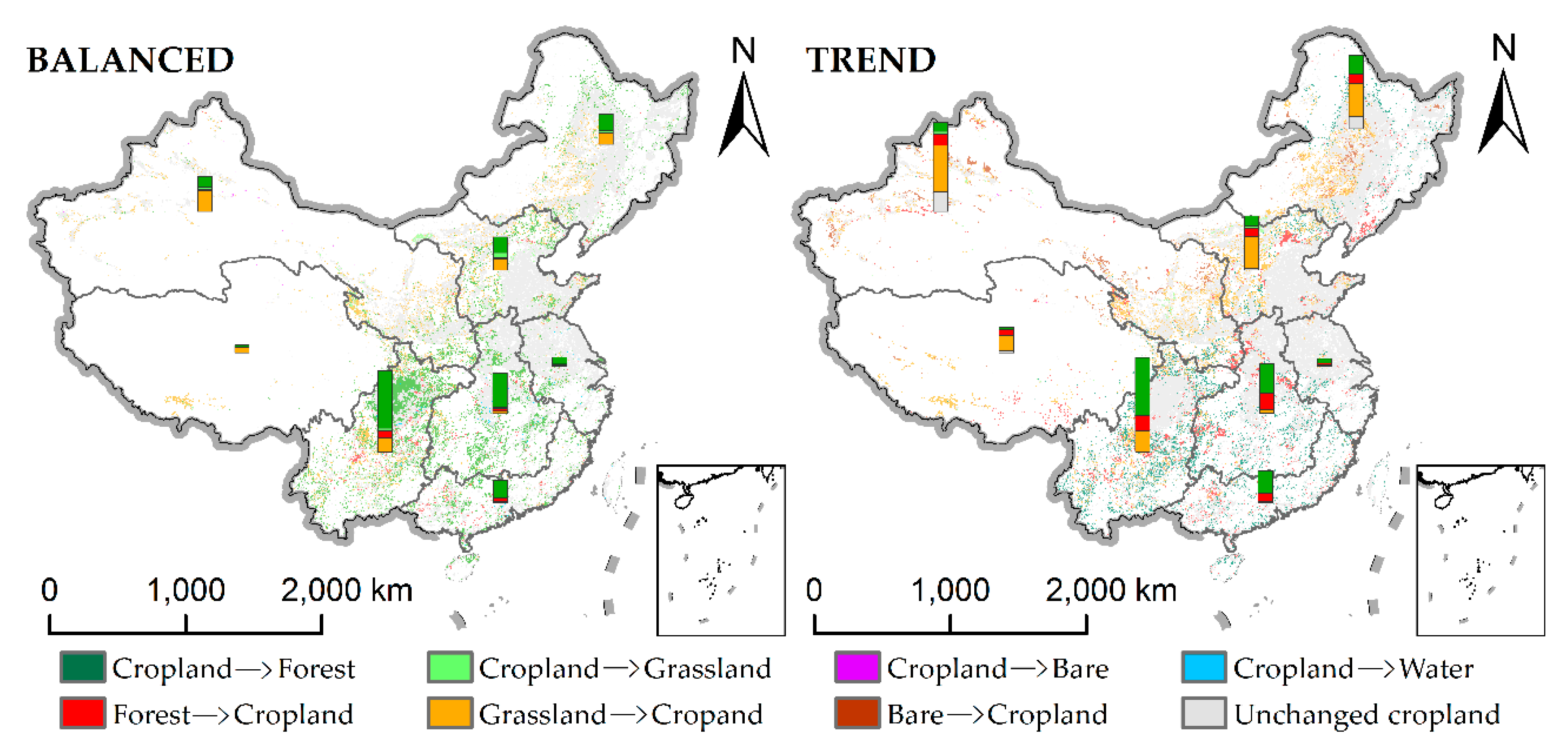
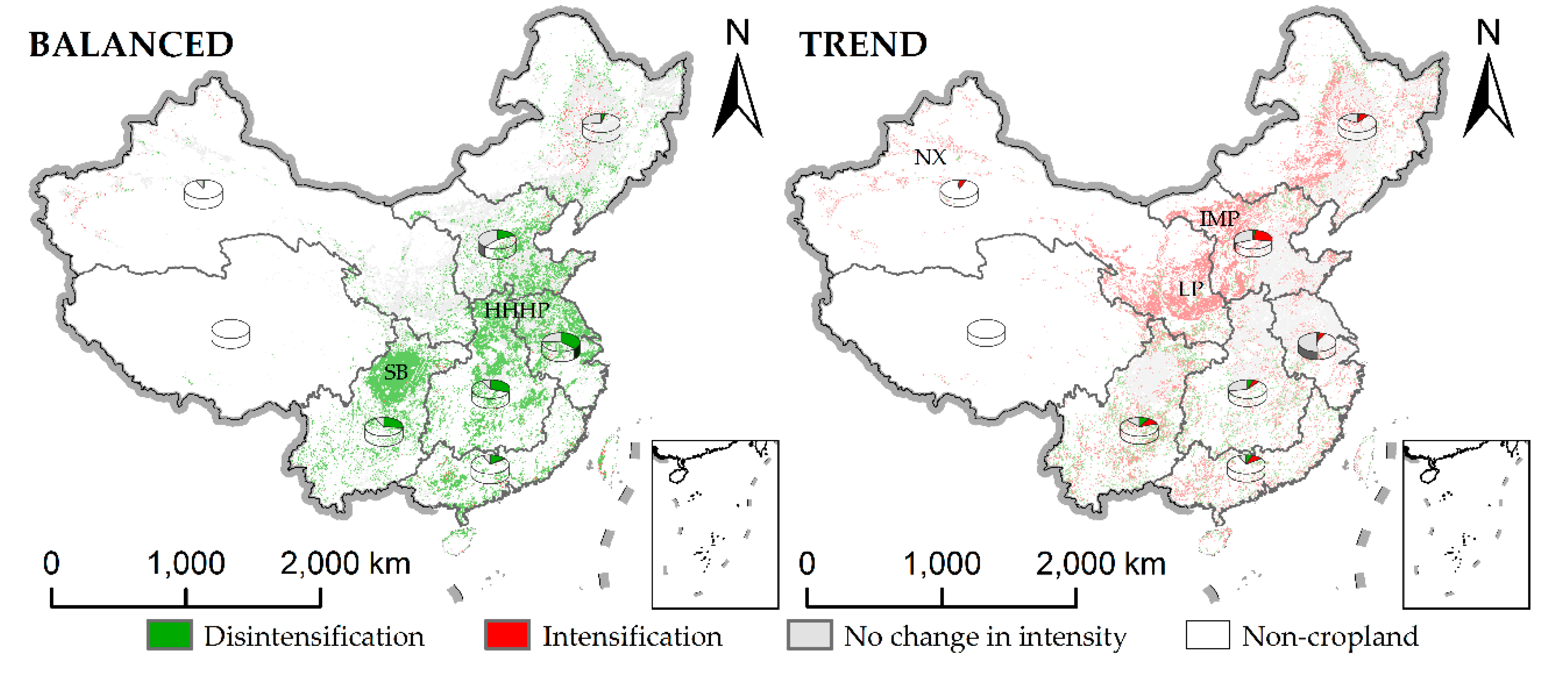
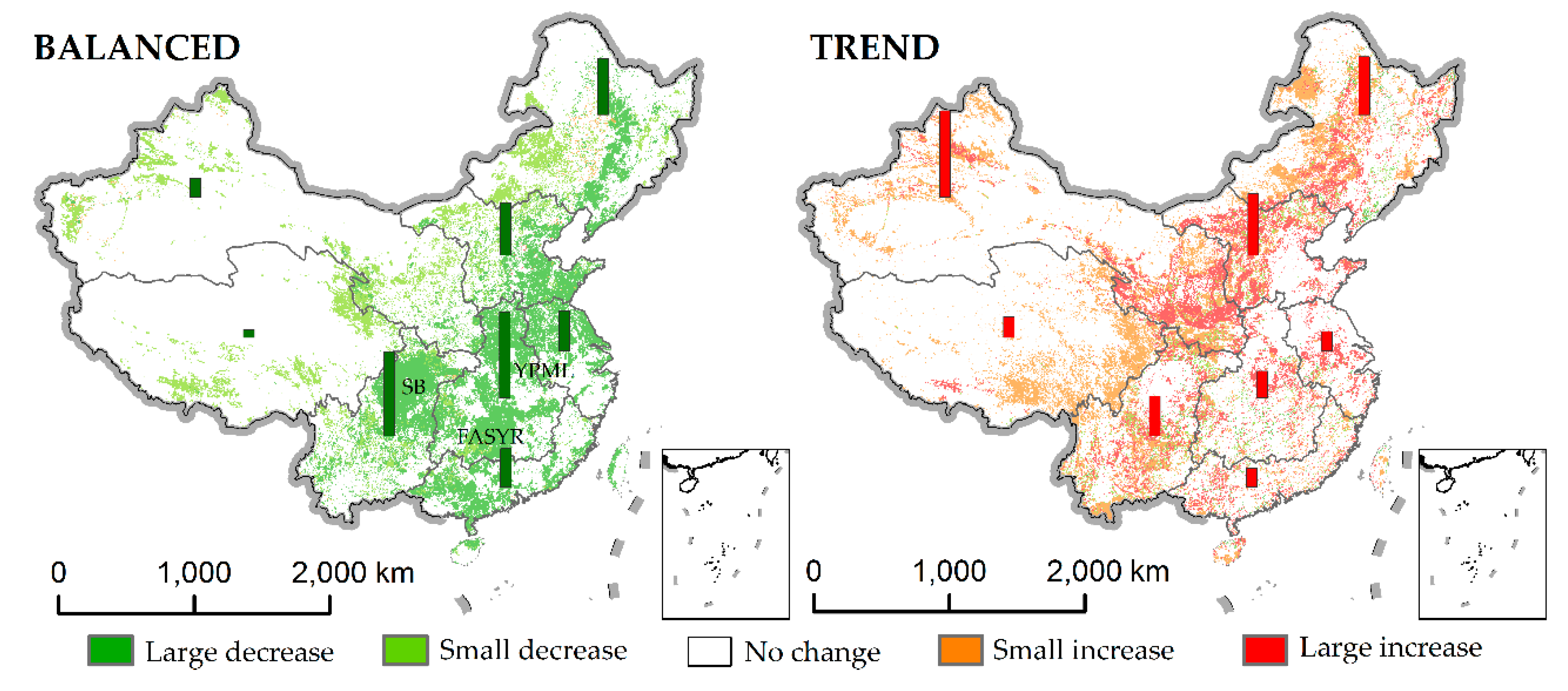
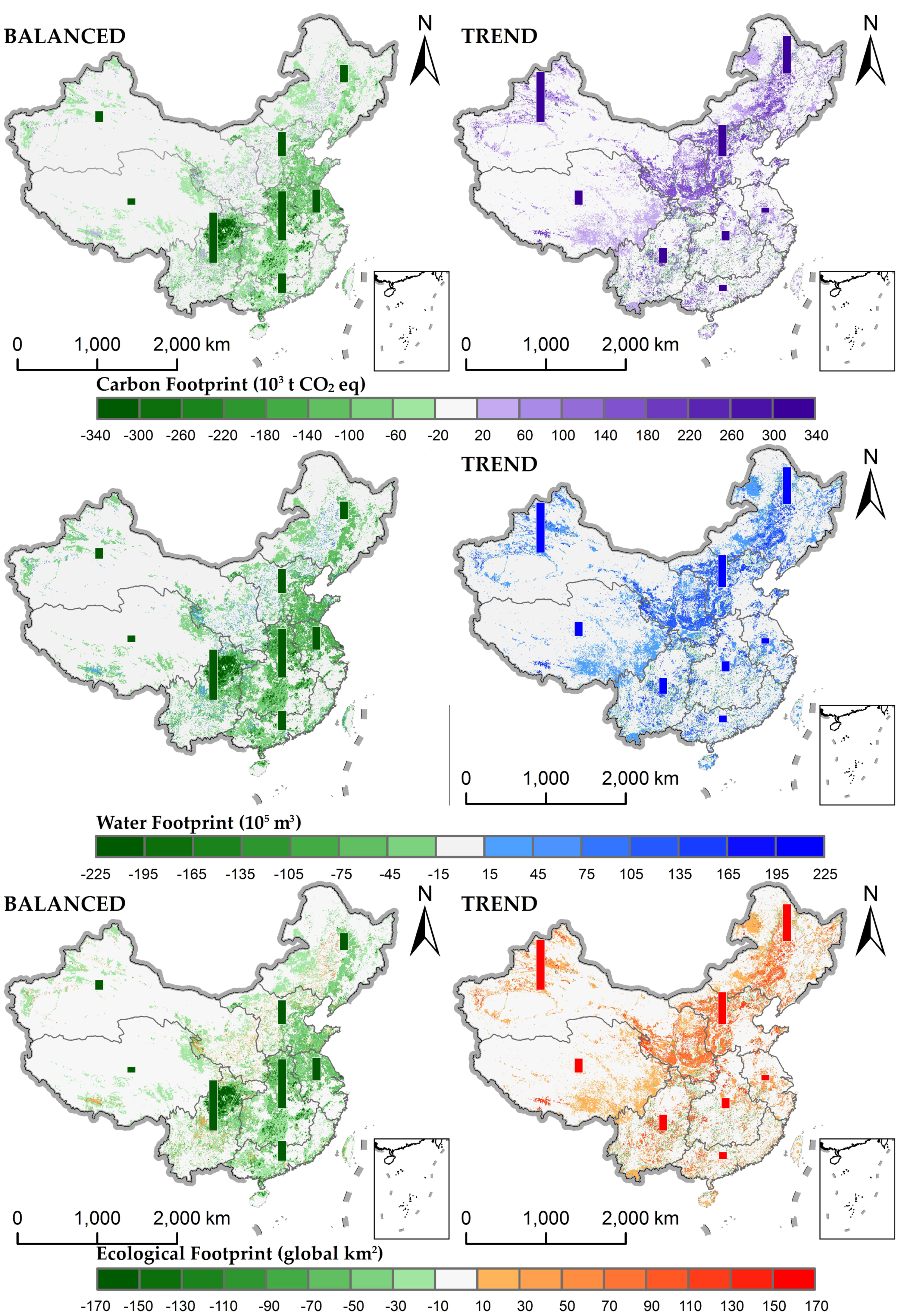
| Category | Factors | Unit |
|---|---|---|
| Climate | Mean annual temperature | °C |
| Annual precipitation | mm | |
| Soil characteristics | Sand content | mass% |
| Silt content | mass% | |
| Clay content | mass% | |
| Soil average erosion modulus | t/km2×a | |
| Topographics | Elevation | m |
| Slope | degree | |
| Vegetation | Normalized difference vegetation index | g/m2 |
| Location | Distance to city | km |
| Distance to water | km | |
| Distance to road | km | |
| Distance to railway | km | |
| Socio-economics | Population density | people/km2 |
| Economic density | RMB/km2 |
| Scenarios | Meat | Crops | Built-up Area | Forest Area |
|---|---|---|---|---|
| TREND | +50.51% | +23.70% | +14.93% | +10.80% |
| BALANCED | −46.85% | −26.97% | +14.93% | +10.80% |
| Researches | Study Area | Dietary Change Scenarios | Spatial Resolution | Environmental Impacts |
|---|---|---|---|---|
| Our study | China | Two scenarios based on current trends and DGCR. | 5 km | Changes in land cover and land use intensity; CF, WF, and EF |
| Song et al., 2019 | China | Two scenarios based on the 2000 and 2013 versions of the dietary reference intake guidelines. | County-level | CF, WF, and EF |
| Vanham et al., 2018 | UK, France, Germany | Three scenarios based on healthy diet with meat, healthy pescetarian diet and healthy vegetarian diet. | Sub-national geographical entities | WF |
| Alexander et al., 2016 | Global | Two scenarios based on the global adoption of the current diets of India and the USA. | Country-level | Changes in agricultural land area |
| Land System Type | LS_01 | LS_02 | LS_03 | LS_04 | LS_05 | LS_06 | LS_07 | LS_08 | LS_09 | LS_10 |
| ROC | 0.96 | 0.88 | 0.89 | 0.87 | 0.94 | 0.86 | 0.92 | 0.79 | 0.78 | 0.86 |
| Land System Type | LS_11 | LS_12 | LS_13 | LS_14 | LS_15 | LS_16 | LS_17 | LS_18 | LS_19 | LS_20 |
| ROC | 0.83 | 0.94 | 0.86 | 0.89 | 0.85 | 0.79 | 0.74 | 0.95 | 0.86 | 0.93 |
| Weighted Mean of ROC | 0.8891 | |||||||||
© 2019 by the authors. Licensee MDPI, Basel, Switzerland. This article is an open access article distributed under the terms and conditions of the Creative Commons Attribution (CC BY) license (http://creativecommons.org/licenses/by/4.0/).
Share and Cite
Huang, J.; Liu, Y.; Zhang, X.; Wang, Y.; Wang, Y. A Scenario-Based Simulation of Land System Changes on Dietary Changes: A Case Study in China. Sustainability 2019, 11, 5196. https://doi.org/10.3390/su11195196
Huang J, Liu Y, Zhang X, Wang Y, Wang Y. A Scenario-Based Simulation of Land System Changes on Dietary Changes: A Case Study in China. Sustainability. 2019; 11(19):5196. https://doi.org/10.3390/su11195196
Chicago/Turabian StyleHuang, Jincheng, Yueyan Liu, Xiaoying Zhang, Yu Wang, and Yisong Wang. 2019. "A Scenario-Based Simulation of Land System Changes on Dietary Changes: A Case Study in China" Sustainability 11, no. 19: 5196. https://doi.org/10.3390/su11195196
APA StyleHuang, J., Liu, Y., Zhang, X., Wang, Y., & Wang, Y. (2019). A Scenario-Based Simulation of Land System Changes on Dietary Changes: A Case Study in China. Sustainability, 11(19), 5196. https://doi.org/10.3390/su11195196




